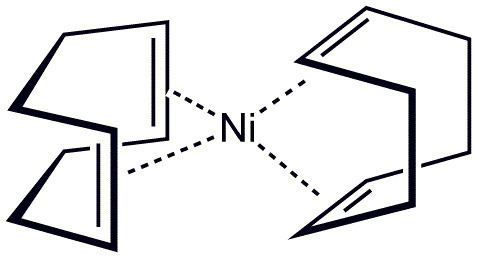 | ||
Organonickel chemistry is a branch of organometallic chemistry that deals with organic compounds feature nickel-carbon bonds. They are used as a catalyst, as a building block in organic chemistry and in chemical vapor deposition. Organonickel compounds are also short-lived intermediates in organic reactions. The first organonickel compound was nickel tetracarbonyl Ni(CO)4, reported in 1890 and quickly applied in the Mond process for nickel purification. Organonickel complexes are prominent in numerous industrial processes including carbonylations, hydrocyanation, and the Shell higher olefin process.
Contents
Overview
Organonickel compounds adopts oxidation state 0 or +2. The resemblance to organopalladium compounds is not strong, although both metals undergo reactions that involve sequences of reductive elimination and oxidative addition reactions.
Many complexes exist of nickel coordinated to an alkene. In these compounds nickel is formally zerovalent Ni0 and the bonding is described with the Dewar-Chatt-Duncanson model. One common representative is Bis(cyclooctadiene)nickel(0) (Ni(COD)2), which contains two cyclooctadiene ligands. It is a 18VE compound with 10 electrons provided by nickel itself and 4x2 electrons more by the double bonds. This solid, which melts at 60 °C, is used as a catalyst and as a precursor for many other nickel compounds.
Ni allyl complexes
Allyl halides react with Ni(CO)4 to form pi-allyl complexes, (allyl)2Ni2Cl2. These compounds in turn are sources of allyl nucleophiles. In (allyl)2Ni2Cl2 and (allyl)Ni(C5H5), nickel is assigned to oxidation number +2, and the electron counts are 16 and 18, respectively.
Nickelocene NiCp2 with +2 Ni oxidation state and 20 valence electrons is the main metallocene of nickel. It can be oxidized by one electron. The corresponding palladocene and platinocene are unknown.
Nickel carbene complexes
Nickel forms carbene complexes, formally featuring C=Ni double bonds.
Nickel 12 VE compounds
Nickel compounds of the type NiR2 also exist with just 12 valence electrons. In solution however solvent molecules always interact with the metal atom increasing the electron count. One true 12 VE compound is di(mesityl)nickel prepared from (allyl)2Ni2Br2 and the corresponding Grignard reagent.
Alkene/alkyne oligomerizations
Nickel compounds catalyze the oligomerization of alkenes and alkynes. This property validated the research and development of Ziegler-Natta catalysts in the 1950s. That discovery shown by nickel impurities originating from an autoclave which killed the propagation reaction (Aufbau) in favor of termination reaction to a terminal alkene: the polymerization of ethylene suddenly stopped at 1-butene. This so-called nickel effect prompted the search for other catalysts capable of this reaction, with results in the finding of new catalysts that technically produced high molar mass polymers, like the modern Ziegler-Natta catalysts.
One practical implementation of alkyne oligomerization is the Reppe synthesis; for example in the synthesis of cyclooctatetraene:
This is a formal [2+2+2+2]cycloaddition. The oligomerization of butadiene with ethylene to trans-1,4-hexadiene was an industrial process at one time.
Formal [2+2+2]cycloadditions also take place in alkyne trimerisation. This extensible trimerisation can generally include benzyne. Benzyne is generated in situ from a benzene compound attached to a triflate and a trimethylsilyl substituent in the ortho- positions and reacts with a di-yne such as 1,7-octadiyne along with a nickel(II) bromide / zinc catalyst system (NiBr2 bis(diphenylphosphino) ethane / Zn) to synthesize the corresponding naphthalene derivative.
In the catalytic cycle elementary zinc serves to reduce nickel(II) to nickel(0) to which can then coordinate two alkyne bonds. A cyclometalation step follows to the nickelcyclopentadiene intermediate and then coordination of the benzyne which gives a C-H insertion reaction to the nickelcycloheptatriene compound. Reductive elimination liberates the tetrahydroanthracene compound.
The formation of organonickel compounds in this type of reaction is not always obvious but in a carefully designed experiment two such intermediates are formed quantitatively:
It is noted in one study that this reaction only works with acetylene itself or with simple alkynes due to poor regioselectivity. From a terminal alkyne 7 isomers are possibly differing in the position of the substituents or the double bond positions. One strategy to remedy this problem employs certain diynes:
The selected reaction conditions also minimize the amount formed of competing [2+2+2]cycloaddition product to the corresponding substituted arene.
Coupling reactions
Nickel compounds cause the coupling reaction between allyl and aryl halides. Other coupling reactions involving nickel in catalytic amounts are the Kumada coupling and the Negishi coupling.
Ni carbonylation
Ni catalyzes the addition of carbon monoxide to alkenes and alkynes. The industrial production of acrylic acid at one time consisted of combining acetylene, carbon monoxide and water at 40-55 atm and 160-200 °C with nickel(II) bromide and a copper halide.
